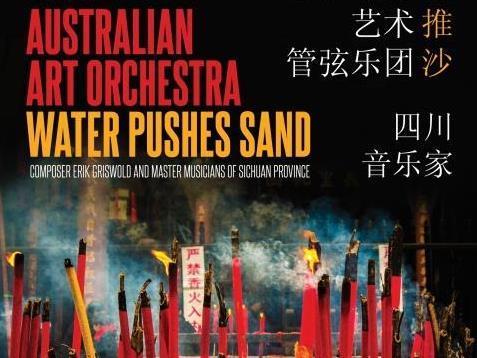Album cover image: Water Pushes Sand, Australian Art Orchestra. Image via Jazzhead Records.
Founded by Paul Grabowsky in 1994, the Australian Arts Orchestra is now renowned for pushing musical boundaries and for its improvisatory and virtuosic skills. The AAO’s latest recording Water Pushes Sand documents a project arising from visits by the composer/arranger/pianist Erik Griswold and percussionist Vanessa Tomlinson to Sichuan Province in south-west China. Making several journeys, Griswold and Tomlinson became immersed in Sichuan percussion, its ‘folk’ music and street songs. Dramaturg Tamara Saulwick and video artist Scott Morrison have contributed to a suite of works that Griswold argues ‘reinvigorates the endangered music of China’s Sichuan Province and in doing so, creates a vibrant and original world of sound’. The project was first performed at the OzAsia Festival in Adelaide in 2015. It toured Australia in August this year and a tour of China is planned in 2018.
The categorisation of ‘folk’ music as opposed to ‘classical’, ‘high’ or ‘low’ culture as might be defined in the West becomes problematic for many ancient Asian cultures and the subsequent Western concepts of ‘historically informed’, ‘authentic’ and ‘crossover’ even more so. Cultural fusion and modern interpretation of the ancient has always been a norm for many Asian artists. In reviewing this recording I have listened in an open-minded and positive spirit towards the project’s aims, though I admit to harbouring submerged concerns about the appropriation of culture, particularly in the use of traditional song and opera in the opening number In the Joy of the Sunrise and the concluding item Changing Faces performed by tenor Zheng Sheng Li. This music is glorious and complete in its own right without any need for it to be borrowed and synthesised into a Western jazz context. But it is, after all, the mission of the Australian Arts Orchestra ‘to stretch genres and break down the barriers separating disciplines, forms and cultures’, so welcome as a comprehensive initiative.
For this recording the AAO comprised an ensemble of 10 Australian and Chinese musicians collaborating in an exciting collision of sound worlds and improvisation. Western instruments (saxophones, trumpet, piano and double bass) are combined with Chinese; for example, the suona (a high-pitched Chinese horn), bamboo flute and the guzheng (a Chinese zither with a 2,500 year heritage). Performances by every member of the ensemble are excellent.
In the joy of the Sunrise is an ecstatic soundscape with rolling waves of sound and shimmering textures, a wash of percussion, distorted saxophone, the blaring suona and trilling bamboo flute with the majestic traditional song regally sung above by high Chinese operatic tenor (Zheng Sheng Li). The Australian Art Orchestra performs with an infectious excitement and verve throughout. Occasionally the pendulum of influence swings away from traditional Asia towards jazz, albeit performed using traditional Chinese instruments. Rivers of Bicycles uses a sound cloud of bicycle bells against calmer melodic material played as an embellished monody later used for extemporisation. Forgotten Streets is a slow and nostalgic improvisation on the quiet streets of Chengdu. Bandong Chant presents a rhythmic Communist working song as its energetic principal material. The quirky Mapo Tofu is a wacky ode to one of the most famous and spicy dishes of Chengdu, complete with searing suona and saxophone solos. Remembering Harry pays homage to the late Harry Castle, an electronic music pioneer and collaborator. The title track Water Pushes Sand takes its inspiration from Sichuan opera, blurring a traditional triple rhythm into a jazz waltz and ending in an all-out riot. Finally Changing Faces with more outstanding singing from Zheng depicts the swift changing of mask in Sichuan opera from one face to another (Biàn Liăn) with the diverting swipe of a fan or wave of hand.
Although most of the material on the recording might be categorised as being on the ‘easy’ side of the spectrum in terms of what the Australian Art Orchestra can produce, I found it infectiously enjoyable listening nonetheless.
A translation of the traditional Chinese songs in the liner notes would have been helpful.
Recommended.
Rating: 4 stars out of 5
Australian Art Orchestra
Zheng Sheng Li, voice
Shi Lei, bamboo flute
Zhou Yu, suona/Chinese violin/bamboo flute
Timothy O’Dwyer, saxophones
Peter Knight, trumpet/Laptop Electronics
Zhou Tao Tao, guzheng
Erik Griswold, piano
Vanessa Tomlinson, percussion
Zhoung Kai Zhi, percussion
Samuel Pankhurst, contrabass
Jazzhead (Head 234)
Recorded October, 2015
Released August, 2017





